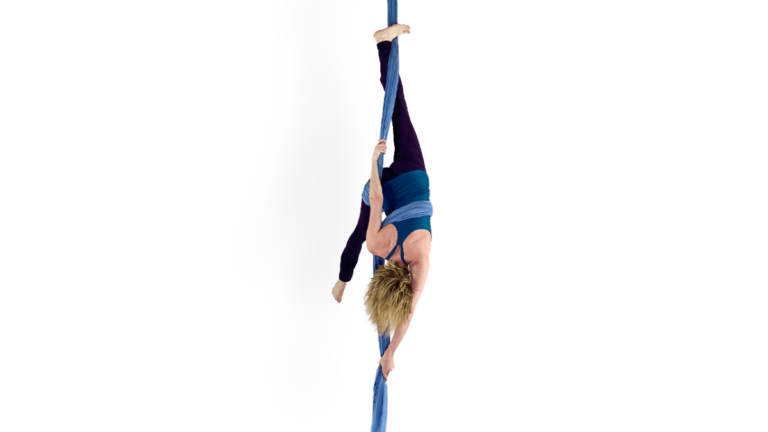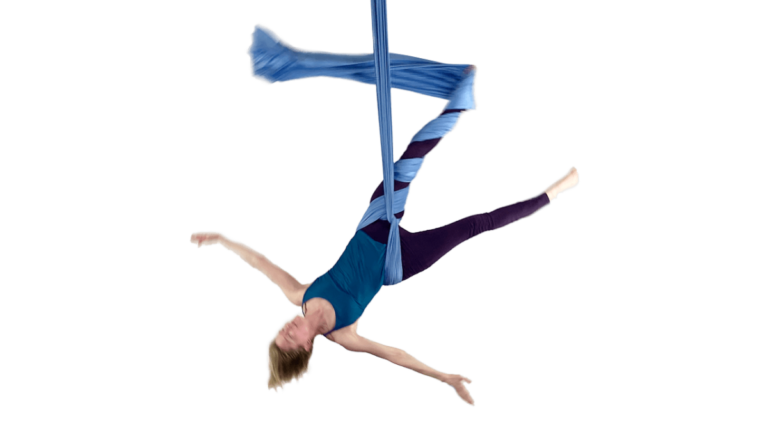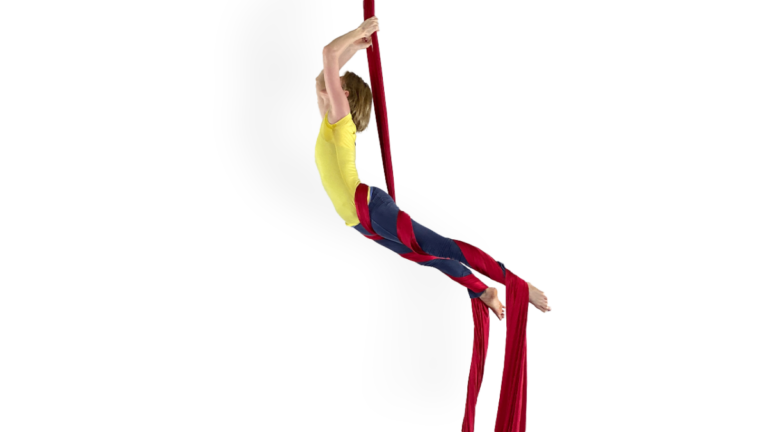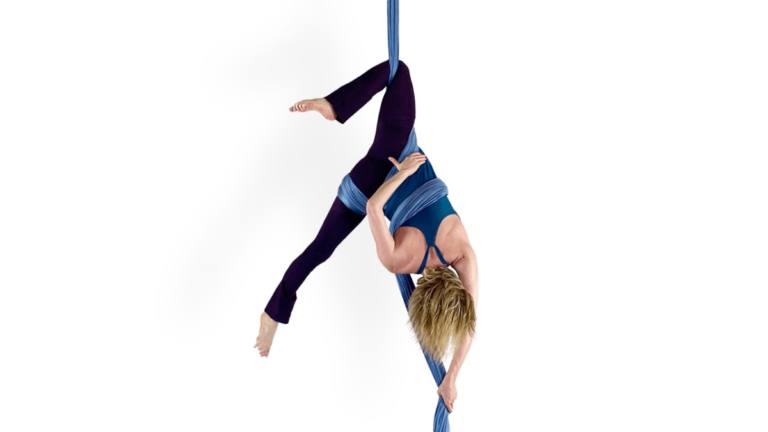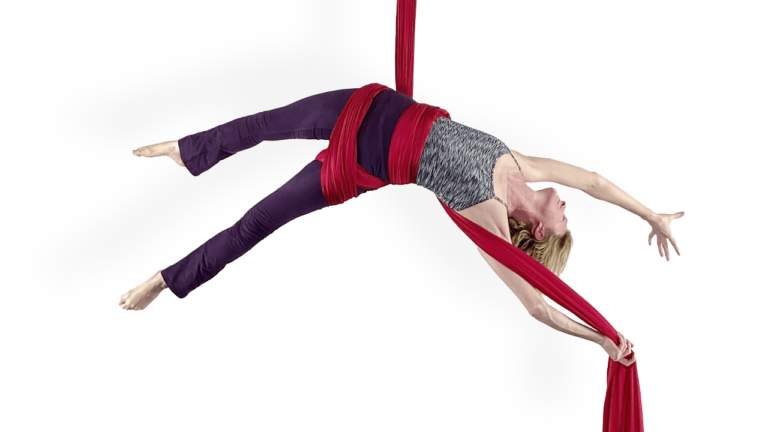Aerial Silks Drops and Dives
Aerial Silks Footlock Skills & Moves
What are aerial silks drops and dives?
There are a huge variety of drops and dives on aerial silks. Despite what it might look like, aerialists are not thrill seekers. We need to be control freaks. Every time we do a drop or dive, everything has to be done correctly. Not just most of the time. 100% of the time.
The idea of falling may seem scary but we always train the foundations, explain the theory, and know how to walk down drops and dives. “Safety First!” should always be a priority. Aerial Silks Drops & Dives are exciting aerial arts skills to be able to do and a great way of continuing education in circus arts.
Different levels of Aerial Silks Drops and Dives.
There are many different levels to drops and dives and it is always important to start slowly and work your way up to harder skills. It is important to understand the basics of aerial silks and feel comfortable before even trying the beginner levels of drops and dives.
Beginner Friendly Aerial Silks Drops and Dives
Gazelle Droplet to Straddle is a mini drop that we teach in our beginner level classes, once students are comfortable with a variety of easier skills in the fabric knot. We first learned this move when our aerial colleague Rebekah Leach showed it to us during a teaching nerd-out session, and after further exploration it became one of the very first drops that we teach our beginner level students.
When we teach this skill we teach our students how to keep themselves safe in drops, so there are actually a lot of cues we consider very important and we go over them in this video.
Cannonball Droplet is one of the very first drops that we teach our students. We teach this towards the midde of our beginner level curriculum, and we use it to teach our aerial silk students how to keep themselves safe in drops. There are a few specific things we’re looking for in students learning this skill, mainly, the ability to maintain strong core engagement and keep their neck in line with their spine as they move through space.
To prepare students for this droplet we make sure we’ve already spent a lot of time drilling them on clean Back Straddles, Pelvic Curls, and V-Ups.
Mission Impossible, also known as Airplane or Skydiver, is an aerial silks move that our students love! It’s really fun and dramatic, but also fairly easy to set up.
There are many different ways to enter and exit this skill, and different ways to stylize it throughout, and our video tutorial covers important basics to get you started. This is a move that’s dramatic when done slowly as we demonstrate in this video, but we still consider it a dive because it requires commiting to the motion and if a student doesn’t stick the pose it can happen quickly.
Like any drop, it’s really important to take the time to dive into how and why it works, and this video dives into the supports of this move as well as the key physical actions needed to make it successful.
Intermediate Aerial Silks Drops and Dives
These skills are going to be a little more challenging and will require more stamina and strength to safely get in and out of them.
This move is a variation of a J roll that we came up with to make the skill safer for students, while at the same time teaching a few specific body positioning cues that we think are important for them to progress to more challenging but related skills. This move is similar to an Arrow Flip, but you can also think of it like an option for walking down a single star drop in an interesting way.
Before teaching this skill it’s important that students are very familiar and comfortable with their same side wraps. There is also some hip mobility and a good sense of spatial awareness required for this skill.
We teach this to intermediate level students who are ready to start learning drops from a same side wrap. We also progress it to a more advanced variation later for students who like it and want to explore more.
Seatbelt Cartwheel is a fun sideways dive that can be added to the bottom of a Star Drop, or anytime you find yourself in an Outside Seatbelt. There are different ways to style and perform this drop, and our students really love it because it’s so much fun and because it’s so tightly wrapped that it feels very secure.
Our teaching progressions focus on getting students comfortable in the support, and then setting up the dive with various amounts of momentum. Less momentum makes it trickier to get around smoothly to finish the dive, but it does help students get comfortable with the small change in direction that happens during the dive. Building up to using more momentum is done over time as students feel comfortable with the direction that they’re going in space.
As always, remember to carefully work each progression before doing a drop full on, and be sure to learn new drops in the presence of an aerialist experienced with the skill.
360 Dive with Leg Wraps, also called Angel Drop or Salto, is often the first wrapped dive that we teach to our students, but that doesn’t mean that we teach it early. We have a lot of preparation and progressions that we put our students through because we want their drops to be controlled, safe, and to feel good on the body long term.
There are many similar drops to this one and also many different set-ups. Our set-up might look slightly different from some, but this video explains exactly why we teach it the way that we do.
Before we ever teach drops like this we teach students choreography and sequences in the wraps themselves, so that we’re not teaching how to wrap at the same time that we’re teaching how to drop. That’s because each piece is equally important for good technique. Our building blocks include inverted wrapped sequences like Double Crucifix Double Thigh Wrap Gazelle that make good preparatory skills for skills like this.
Advanced Aerial Silks Drops and Dives
This version of the Wrapped J Roll is something we teach at a higher level, only after students are very familiar with the easier variation that we teach first, which is detailed in our building blocks. Once that easier variation of Wrapped J Roll is very consistent and strong, then we progress students bit by bit into this version.
This video details progressions that we use, on the floor to understand the grip required, and in the air using smart hip movements to walk it through. Going through our progressions helps students understand and trust that the grip is correct before committing fully to this skill.
This dive builds on the Hip Key Thread Through Dive by adding another movement at the bottom. This video looks at how we approach teaching the second rotation into Scorpion, once that first variation, detailed in our Building Blocks, has been mastered.
There are many ways to style this dive, and in addition to styling options this video also covers two different exit options to remove the wrap at the end.
This is an intermediate level dive and if the set-up is not 100% correct it can go wrong, so make sure to train dives in the presence of someone with an experienced eye, to have extra safeties in place when approaching moves like this.
Starlette C-Shaping on Aerial Silks is one of our favorite ways to have students work on slow star drops. Starlette Drop is a good place to begin the practice of c-shaping down a Star Drop, because the extra friction of the wraps makes it easier to succeed. We teach this slow controlled drop variation once our students are comfortable with dropping a Starlette, and once they’ve worked on C shaping techniques including in Creature Roll and many other ground drills.
This video goes into detail about several different starting positions for C-shaping down the Starlette Drop, and details about how to make it work so that the drop is nice and slow.
We like to teach our students to C-shape down this version of Star Drop because it helps build confidence before taking it to a bigger skill like Double Star.
These are just some of the many aerial silks drops and dives. For continuing education, see what else you can learn about drops and dives, simply browse the many levels and skills of aerial art.
Tips for Learning Aerial Silks Drops & Dives
1. Always start small.
Don’t try intermediate or advanced skills if you’re just beginning. Learning aerial arts is a long journey and a daily practice, which is why we’ve broken down our skills into progressions for you
2. Avoid common mistakes.
For each skill in our library, you’ll find lessons on common pitfalls and advice for how to avoid them. Simply scroll down the page on each video lesson.
3. Don’t go it alone.
If you get stuck, you’ll want to have a coach or community to go to for help. Become a member today to access the AFO community.




